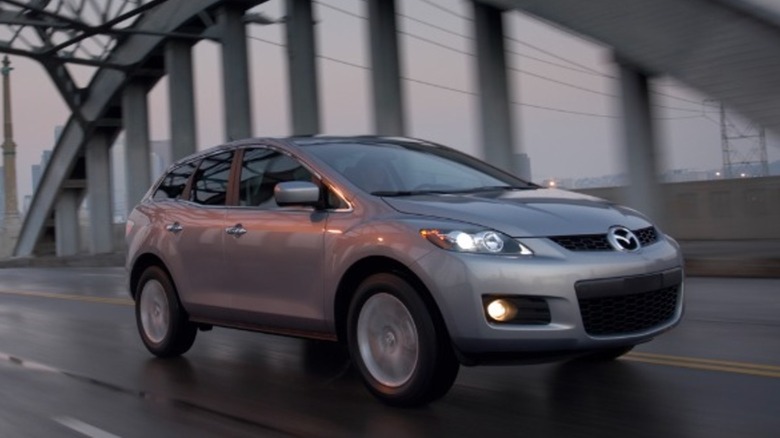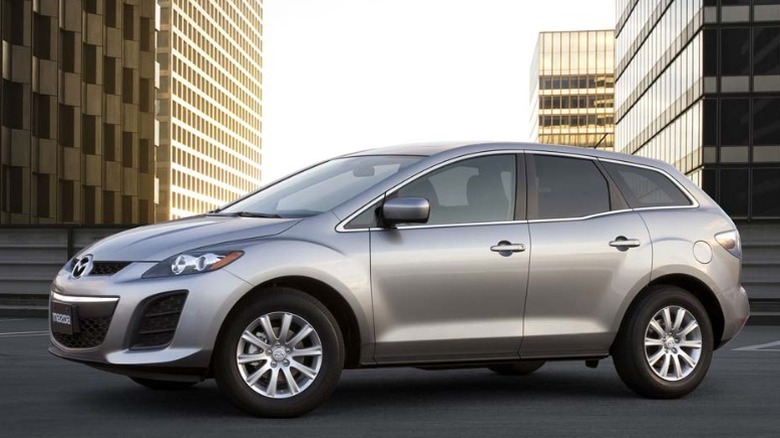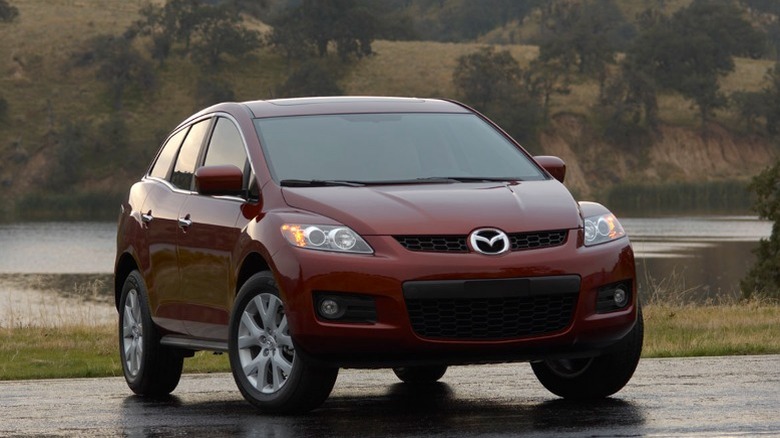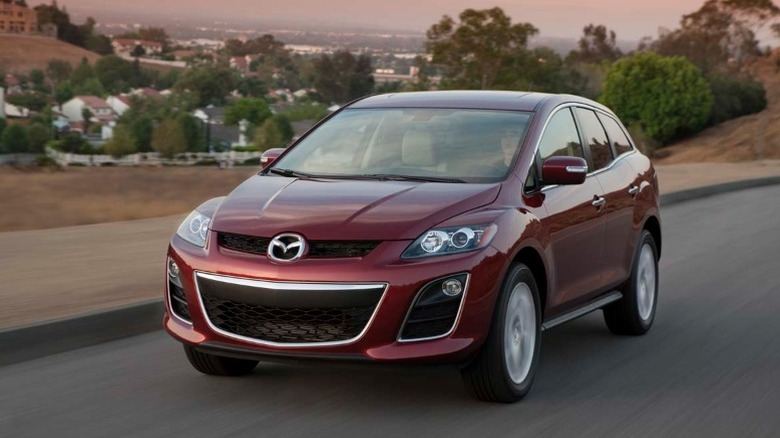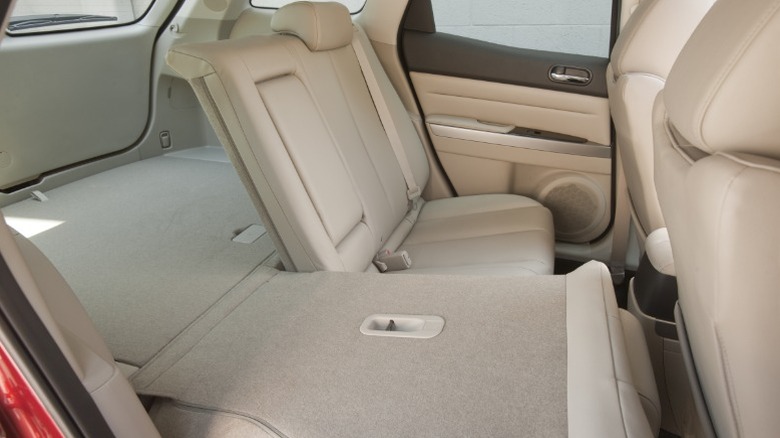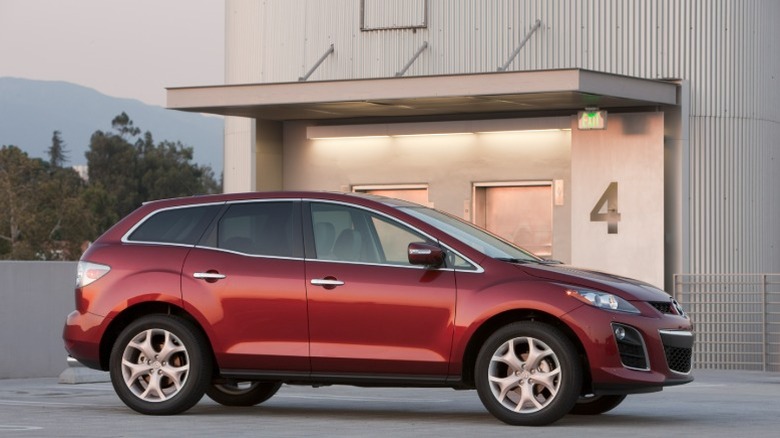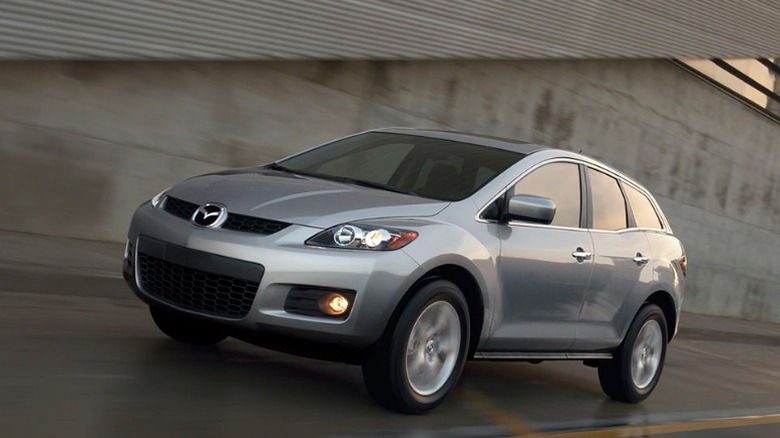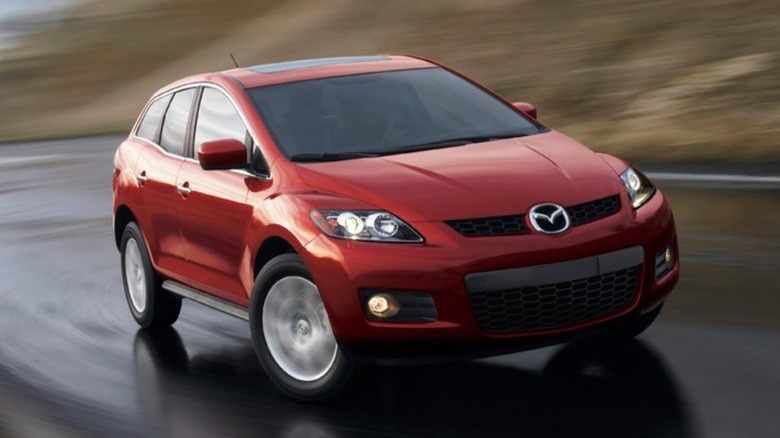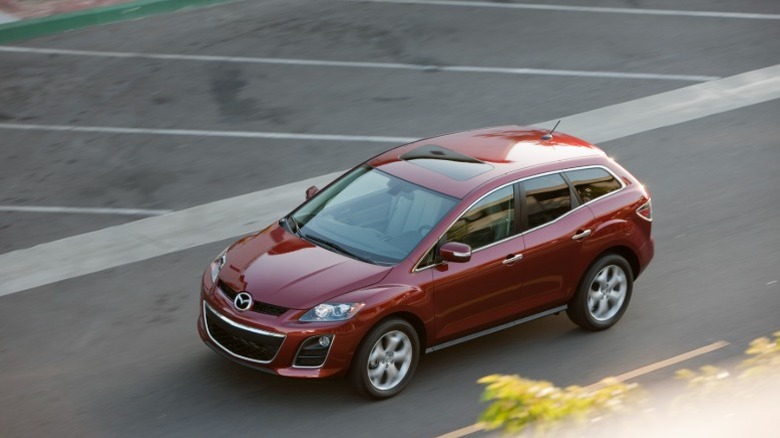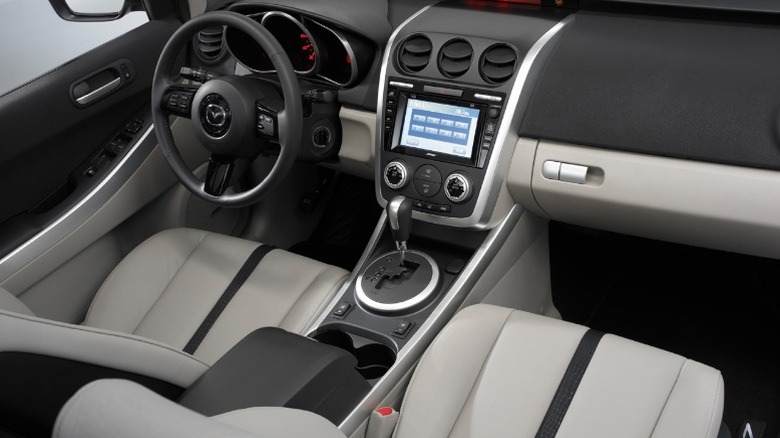10 Things You Should Know Before Buying A Mazda CX-7 (New Or Used)
Mazda's lineup has gone through some changes over the past years, with models like the CX-30 and CX-50 becoming the center of attention and older names like the CX-7 quietly fading into the background. But for some buyers, the CX-7 is still a solid pick.
The Mazda CX-7, a sports-crossover SUV, was introduced in 2006 and discontinued after the 2012 model year, but it made a brief but memorable run in the SUV market. So while it didn't actually go out with a bang, it also didn't completely disappear either. Instead, it remains in that in-between space of quirky, slightly misunderstood, and surprisingly capable if you find the right one.
If you're here because a CX-7 caught your eye for its price or styling or even some other reason, and are wondering if it's worth looking into as your next daily driver, we'll go over what made the CX-7 work, where it went wrong, and which budget suits the used models on the secondary market. Here are 10 things to know when purchasing a Mazda CX-7.
Know your generations
In a sort of good sense, the Mazda CX-7 is a bit of an oddball in the company's SUV lineup. It only lasted one generation, covering model years 2007 through 2012. While a major reason it was discontinued was its considerably low number of sales, another reason was so it could open the door for the release of the Mazda CX-5.
The CX-7 came at a weird time for the brand. Just when Mazda was trying to transition away from its Ford-heavy platform days and establish its own design identity. It became difficult to categorize the CX-7 because it was in the middle of the small and midsize ranges. It was neither as large as the CX-9 nor as light as the following CX-5. Mazda, however, made driving sensation its priority, which was perfectly in line with its universal slogan: zoom zoom.
Over time, Mazda's trim levels (Sport, Touring, and Grand Touring) progressively evolved. In 2010, the company released a facelift that included improved inside materials, tighter headlamps, and a cleaner front fascia. Apart from that, the 2007 and 2012 versions didn't have too many differences. And so because of this uniformity, buying a used CX-7 is a little simpler. Just keep an eye out for differences in infotainment and standard technology, especially in early versions that didn't come with Bluetooth or navigation.
Two engines, two personalities
Before purchasing a Mazda CX-7, one of the most important things to understand is that you are effectively making a decision between two very different personalities. Mazda offered the CX-7 with two engine options over the years, and they behave very differently.
The early CX-7s (2007 to 2009) came with a 2.3-liter turbocharged four-cylinder that came from the MazdaSpeed6. With its 244 horsepower and 258 lb-ft of torque, rapid acceleration, and a sportier edge over the majority of SUVs in its class at the time, it appears to be the most exciting one on paper. However, the engine uses expensive fuel, is thirsty, and has a history of carbon buildup and problems with the turbo if it isn't properly maintained.
A new 2.5-liter four-cylinder naturally aspirated engine was made available as a base option by Mazda by 2010. Sure, it wasn't as much fun, but it was more in line with what the majority of SUV customers really wanted: less maintenance, fewer repairs, and better fuel economy. Although it only produced 161 horsepower, it was smoother and more manageable over time. Regular fuel is also used in this version, which lowers the cost of ownership.
The turbocharger can be worth the risk if you prefer sporty driving and are prepared to look into a car's service history. But the 2.5-liter model is the more sensible and stress-free option if all you want is a dependable daily SUV with respectable power.
What's the price tag like?
Whether or not you're looking for a used Mazda CX-7, the numbers tell an interesting story. When the CX-7 was first released, it was priced competitively with competitors like the Honda CR-V and the Nissan Murano, starting at about $23,750 for the base model and creeping up to $30,000 with options for the higher-end Grand Touring trims, especially the turbocharged models.
Today, the used market is where the CX-7 really turns heads. Listings on TrueCar range from $3,500 to almost $9,000, depending on region, mileage, and trim. For a 2010–2012 model with fewer than 100,000 miles, the sweet spot usually falls between $6,000 and $7,500. Even a well-maintained 2007 Grand Touring may sell for less than $5,000 now, according to Edmunds.
A reasonably well-maintained CX-7 won't break the bank if you're searching for a second or commuter vehicle. Moreover, the whole lineup is currently only available on used car listings because Mazda retired the model after 2012. This means that your budget primarily comes down to how new you want your model year and how many miles you're prepared to put up with. Therefore, just on price alone, it's easy to see why the CX-7 continues to appeal to budget-conscious buyers.
Roomy enough, but not exactly the best cargo carrier
Though the Mazda CX-7 isn't aiming to win any cart-carrying contest, it still offers plenty of space for everyday life. It has 29.9 cubic feet of load space behind the second row — fair for a small SUV. And when the back seats are folded down, the space increases to a generous 58.6 cubic feet, which is sufficient for weekend luggage, a long shopping run, or even a few travel crates if you're the dog parenting kind.
When carrying longer objects, the split-folding arrangement (60/40) makes it easier to work with, and the back seats do fold almost flat. In the rear cargo area, Mazda included some underfloor storage, which is useful for carrying tools, roadside kits, or jumper cables. Still, it can be a little difficult to load larger boxes because the cargo floor itself isn't entirely level when folded.
With well-braced seats and a cleverly arranged center console, the front row feels spacious inside. Just be aware that the rear headroom and legroom aren't exactly the best fit if you have tall passengers in the back or if you intend to pack all five seats for a road trip. It is ideal for average-height individuals because it has 39.7 inches of headroom up front and 39.3 inches in the back. Of a truth, it is helpful, but not in the sense of "let's pack up the entire garage," but more in the sense of "let's go grocery shopping."
Not all years are created equal
The Touring and Grand Touring trim levels of the 2011 and 2012 model years are often regarded as the most desirable. Because by then, Mazda had addressed the biggest pain points of the CX-7. By 2010, the base motor was the 2.5-liter four-cylinder engine, which suffered from reliability issues in the previous years, and offered better fuel economy and fewer difficulties than the turbocharged 2.3-liter. It's little wonder the quality and reliability of the 2011 version is given a score of 78 out of 100 by J.D. Power.
There is a history of mechanical problems with the 2007 and 2008 CX-7s, especially with the 2.3-liter turbo. Some common complaints are engine sludge, blown turbos, and even premature timing chain failure, which are linked to poor oil maintenance or quirks in the design. According to NHTSA data and some user forums, some of these problems surfaced before hitting 60,000 miles. Although Technical Service Bulletins (TSBs) were issued by Mazda, many of these problems were not fully recalled, painfully leaving the owners to bear the burden.
It's also important to note that major improvements in infotainment and safety technology weren't made until after 2010. So if Bluetooth, a backup camera, or a more upscale dashboard matters to you, the later trims are your best shot. The 2011–2012 Grand Touring vehicles even include high-end features like leather upholstery, Bose speakers, and advanced climate control.
Common issues to watch out for
Since every CX-7 on the market is over a decade old, gathering as much information about a potential purchase's specific history is paramount. Before signing any paperwork, you should know of a few potential problems that have plagued general CX-7s.
The timing chain tensioner is the most prominent. It is well-known weak point, particularly in versions with the 2.3L turbocharged engine from 2007 to 2009. You might hear rattling on cold starts when it kicks off, indicating that the chain is loosening, and this could cause serious engine damage if ignored. Mazda issued a TSB (Technical Service Bulletin) and updated the tensioner design in later years, but early units that didn't get the fix would need to be checked by the mechanic before a purchase.
Many CX-7s also suffered from early turbo failure, especially those that didn't receive regular oil changes on time. One major cause was sludge buildup, which frequently resulted in smoke, power outages, and complete turbo replacements far before the 100,000-mile milestone. You might want to look out for a clean service record, as a neglected turbo failure could amount to thousands of dollars in repairs.
Another noteworthy problem is the A/C compressor, which tended to malfunction in models from 2007 to 2010. Though it's not harmful, it can be a pain during hot weather. Even more seriously, Mazda recalled more than 190,000 CX-7s because of rust surrounding the suspension, which may have impacted the steering in versions manufactured from 2007 to 2012. So if you're getting a used one, ask the seller for recall documentation or check with Mazda directly to confirm that the repair was completed.
Fuel economy is mid
You might want to think twice if you're the kind of driver who logs a lot of miles on long journeys, especially when it comes to fuel economy. Neither of the CX-7s two engine choices is very fuel-efficient, and even the most cost-effective model can fall short of expectations in 2025.
The EPA estimates that the 2.5-liter naturally aspirated engine, which is mostly found in front-wheel drive Touring and i Sport models, gets 20 mpg in the city and 27 mpg on the highway, which is not exactly spectacular. Also, the more powerful 2.3-liter turbocharged engine, which is found in s Touring, and Grand Touring AWD models, lowers those figures to 17 mpg in the city and 22 mpg on the highway. These figures are backed by drivers on websites such as Fuelly, who record average fuel economy for the turbo models as ranging from 19 to 21 mpg, depending on driving conditions and habits.
The CX-7 is not a fuel miser, and its curb weight, AWD configuration (in many trims), and outdated powertrain technology don't help matters. However, some owners have managed to get a little more mileage by driving carefully. Conclusively, this car isn't the best option if you want to save fuel. Nevertheless, you might not mind too much if you're willing to pay a little more for a more dynamic experience, mainly in the turbocharged models.
Some of it features aged well
If you step into a well-kept Mazda CX-7 today, you might be surprised by how little it feels like a "vintage" SUV. It probably won't wow you with modern tech like Apple CarPlay Ultra or wireless charging pads, but some trims, especially the 2010–2012 Grand Touring, nonetheless exude a certain quiet assurance.
First of all, the top-tier versions included dual-zone climate control, a motorized driver's seat, and leather-trimmed seats, all of which are still considered luxurious features in a car of this age. An auto-dimming rearview mirror, rain-sensing wipers, and heated front seats are further features that wouldn't seem out of place even in a vehicle years newer. Navigation was available too, but it appears more outdated than useful by today's standards.
It's pleasant that Mazda maintained an intuitive and clutter-free cabin. Remarkably, the dashboard arrangement is tidy, and the functions are physically accessible, making it simpler to live with than some contemporary automobiles with clunky touchscreens. Toward the conclusion of its run, the rearview camera was also made available, which was a useful tool for parallel parkers in tight spaces. So no, it's less than likely a tech showpiece. But if you manage to get a well-equipped CX-7, you'll find plenty of everyday comforts that are still usable in 2025.
Turbo versions need religious maintenance
Take a deep breath and get a calendar if you're interested in one of the CX-7's turbocharged variants, particularly the 2007–2010 vehicles with the 2.3-liter MZR DISI Turbo. You can't disregard this engine and hope for the best. Because even though it's powerful, it runs hot and is not really forgiving of neglectful maintenance.
Mazda's own maintenance schedule makes it clear that turbo models need a little extra care. This turbocharged engine relies on a high-temperature exhaust manifold setup, and the oil must work harder to keep the engine lubricated and cool. You should also constantly monitor the cooling system and replace spark plugs every 75,000 miles.
Many owners on CX-7 forums will tell you the same thing: Take good care of it, and it will last. If you skip a few oil changes, you may be at risk for clogged oil passages, turbo failure, or even worse damage. Inasmuch as we don't want to scare you, a thorough maintenance history should be requested if you're purchasing a used turbo model. And if one is unavailable, you may want to start budgeting for repairs. In terms of average cost to own and maintain, RepairPal estimates the annual maintenance for a CX-7 at around $470, which is on par with other compact SUVs of its era.
It is okay in terms of reliability
There were several problems with CX-7s built between 2007 and 2010, especially those with the 2.3-liter turbocharged engine. Owners often complain of oil sludge buildup and turbo seal failures, as mentioned earlier. These issues were frequently caused by the turbo engine's high heat environment and minimal oil changes, making maintenance crucial to long-term reliability.
Mazda seemed to have taken that feedback to heart. By 2010 and 2011, the naturally aspirated 2.5-liter engine was a welcome addition to the CX-7 lineup. This powerplant is objectively more reliable, in addition to being more forgiving. With only basic maintenance, several owners have driven the 2.5L well over 150,000 miles. So understanding what you're purchasing is vital, as expenses can be multiplied by a model with inconsistent service records or postponed maintenance.
So is the CX-7 reliable? It depends. While the 2.5L versions typically withstand basic maintenance quite well, the turbo trims are sometimes a bit of a gamble. With different year versions having different reliability ratings, the 2012 version leads the pack by earning a score of 4.6 out of 5 from the consumer reviews on Cars.com.
